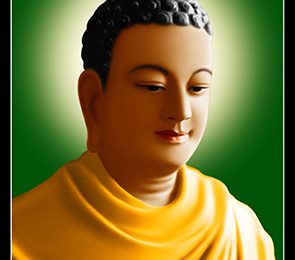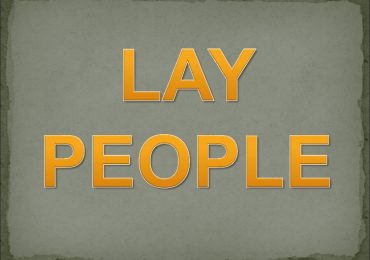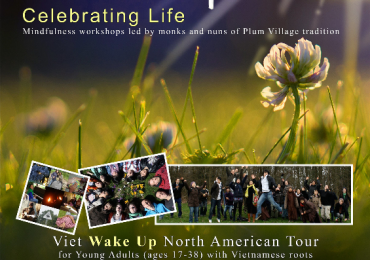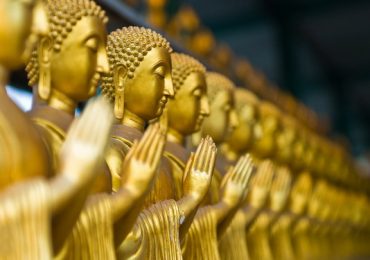A brown-robed sister led me down a hallway lined with doors. She opened one, but he wasn’t there, though the table inside was set with tea. Then she opened another and there, behind door number two, was the renowned monk. Thich Nhat Hanh was stretched out on a green hammock, drinking oolong from a clear cup and nibbling on candied ginger.
He very kindly insisted that I also enjoy some tea and ginger, but I had trouble being mindful of the flavors. I was too nervous about the interview I was launching into. Yet there was no reason for that. For an hour, Thich Nhat Hanh chatted with me, with all his characteristic warmth and profundity. Much of our conversation was woven into In the Country of the Present of Present Moment, a feature in the Shambhala Sun’s current issue (shown here), and in the sidebar You Don’t Need to Be Buddhist. But now, here, I’d like to share another segment of our conversation, exclusive to the Shambhala Sun blog.
You created the five mindfulness trainings to be a distillation of four noble truths and the noble eightfold path. Can we talk a little about the five mindfulness trainings?
The first one is about protecting life and is motivated by the insight of interbeing and compassion. The second is about true happiness. True happiness is not made of fame, power, wealth, or sensual pleasure, but rather it’s made of understanding and love. You don’t need to run into the future to look for happiness. The capacity to live in the here and the now allows you to recognize so many conditions of happiness.
What about true love, the third mindfulness training?
Love and sexual desire—they are two different things. Sexual desire without mindfulness and compassion can cause a lot of suffering for you and for the other person. But true love always brings joy and happiness. According to this practice, sexual activity should not take place without love, understanding, and a deep commitment made known to friends and family. True love will not create suffering because it is based on the insight of interbeing. Your suffering is his suffering; her happiness is your happiness. So there’s no longer any discrimination—harmony is possible, and fear and anger are not possible anymore.
Then the fourth mindfulness training is about compassionate listening and loving speech.
It has the power to restore communication and to bring reconciliation. If you learn how to practice the fourth mindfulness training, you can end relationship difficulties that may have lasted several years in just a few days of practice. You can bring back harmony, mutual understanding, and happiness. Then the fifth mindfulness training is about right consumption. Many people consume because they want to cover up the suffering inside. They don’t need to eat but they eat in order to get rid of loneliness, depression, or despair. They read magazines, they go to the internet, they play music, they drive their car—all just to cover up and run away from their suffering. But by consuming these things, they bring more toxins, more violence, and more craving into themselves. In Buddhism the practice is to take care of your own suffering. If you understand your suffering, you will understand the suffering of the other person more easily. When you understand the suffering of the other person, you are not angry at him or her anymore, and you try to do or say something to help him or her suffer less. That means recognizing the suffering in the other person helps compassion to arise in you, and when there is compassion in your heart you don’t suffer anymore. Instead, you try to help. Right consumption can help your family, your society. Right consumption can preserve the earth.
I understand that your international sangha is working to bring the practice of mindfulness into schools.
It is possible to bring this kind of practice into schools of each level. You don’t have to use Buddhist terms. Maybe each week there is one hour of global ethics taught and every day teachers and students learn concrete things like how to breathe, how to relax, how to release the tension in their bodies. If teachers and students know how to breathe and walk in such a way that can help them be in the present moment, they will learn to appreciate the many conditions of happiness that they have. They will appreciate peace—not having to run under bombs—and they will appreciate not having to go ten miles to fetch water for drinking. There are so many conditions of happiness: going to school, evenings at home, family, having something to eat and a house to live in. Many children in the world don’t have these things, so breathing and walking not only help the students to release tension, but they also help students to recognize the conditions of happiness that they have. This is the teaching of the Buddha: It is possible to live happily in the present moment. Teachers can train themselves to live like that, in order to help students to live like that. In Plum Village we have been training schoolteachers in many countries to do this work. We hope to bring the five mindfulness trainings into schools, not in terms of theory, but in practice. Now in Bhutan there is a course given to schoolteachers all over the country, training them to bring this practice into schools. In California we have talked with Governor Brown about this and he said that we will have to begin with a few schools first, so he asked us to train the teachers in two schools in Northern California. Then later, after publishing the results, we might make a proposal so that other schools can adopt the practice.
How does your sangha work with the five mindfulness trainings?
Every two weeks we come together to recite the five trainings and discuss how to better apply them into our daily life. This kind of practice can help reduce suffering very quickly and bring more happiness.







